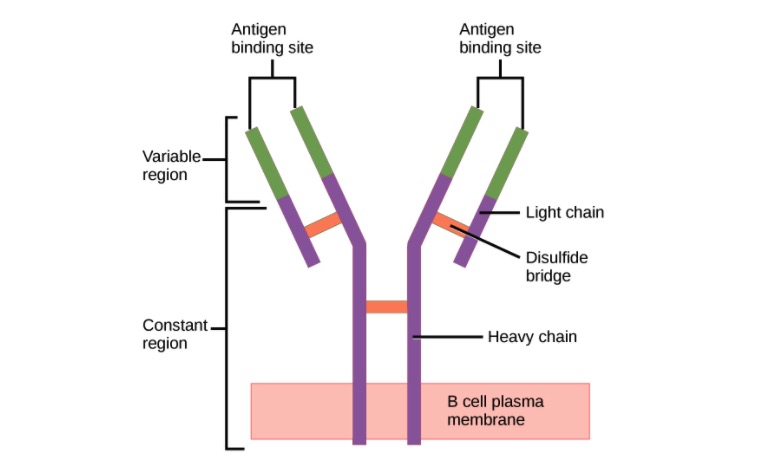Playlist
Show Playlist
Hide Playlist
Humoral Immunity: T-Dependent, T-Independent Antigens, and Class Switching
-
08 Slides Humoral Immunity.pdf
-
Download Lecture Overview
00:01 The term T-dependant antigen is used to denote the fact that most B-cell responses require assistance from helper T-cells. 00:10 So an antigen will be taken up by a dendritic cell, it’ll be processed and presented to a naïve T helper cell. 00:19 This T helper cell will then interact with B lymphocytes and cause their proliferation and differentiation into plasma cells. 00:32 These plasma cells will go on and secrete a soluble version of the antibody molecule. 00:40 The interaction of the helper T-cell with the B-cell can be facilitated by the fact that the B-cell itself can act as a professional antigen presenting cell for antigen experienced T helpers. 00:55 In other words, dendritic cells are required to activate naïve T-cells, but once they have been activated by a dendritic cell, the B-cell can take over that function of acting as a professional antigen presenting cell; showing peptides to the T-cell receptor on the helper T-cell. 01:14 However some antigens are T-independent antigens with respect to the B-cell response. 01:22 These are antigens that tend to have repeating structures which extensively cross-link the B-cell receptor or cross-link Pattern Recognition Receptors and the B-cell receptor together. 01:35 But because T-cells do not participate in the response to these T-independent antigens, there is no class switching and only IgM is produced. 01:46 Because in order to get class switching to IgG or IgA or IgE production, you need CD40 ligand on the surface of the T-cell to interact with CD40 on the surface of the B-cell. 01:57 And if there’s no T-cell involved, then that class switching will not occur. 02:02 Examples of T-independent antigens include bacterial lipopolysaccharide, capsular polysaccharides of bacteria and polymeric proteins. 02:14 So here we can see a T-independent antigen with multiple repeating structures on its surface, powerfully cross-linking the B-cell receptor on the surface of the B-lymphocyte. 02:27 This will cause the B-cell to proliferate without any assistance from helper T-cells. 02:33 And those B-cells can differentiate into plasma cells. 02:37 But those plasma cells will only secrete the IgM class of antibody and tiny little bits of IgD antibody as well. 02:45 But they will not class switch to produce IgG, IgA or IgE. 02:51 For T-dependant antigens which is the vast majority of antigens, B-cells can be induced to class switch following interaction with appropriate helper T-cells. 03:03 So here you can see a naïve B-cell co-expressing on its cell surface, IgM and IgD antibodies of identical antigen specificity. 03:13 You can also see on the surface of the B-cell, the MHC Class II peptide and the molecule CD40. 03:21 In the presence of helper T-cells, the CD40 ligand molecule on the surface of the T-cell interacts with the CD40 on the surface of the B-cell. 03:32 This interaction will cause the helper T-cell to release cytokines and this combination of CD40 ligand binding to CD40 on the B-cell together with cytokines will cause the B-cell to class switch. 03:48 In this particular example, it is switched to produce the IgG class of antibody. 03:55 These B-cells will then differentiate into plasma cells and secrete a soluble version of the IgG antibody.
About the Lecture
The lecture Humoral Immunity: T-Dependent, T-Independent Antigens, and Class Switching by Peter Delves, PhD is from the course Humoral Immunity and Cell-mediated Immunity. It contains the following chapters:
- T-Dependent Antigens
- T-Independent Antigens
- Class Switching
Included Quiz Questions
Class switching of B cells may be brought about by which of the following proteins?
- Cluster of differentiation 40 ligand on the surface of a T-cell
- Cluster of differentiation 40 ligand on the surface of a B-cell
- Cluster of differentiation 40 receptor on the surface of a T-cell
- Cluster of differentiation 28 receptor on the surface of a T-cell
- Cluster of differentiation 28 ligand on the surface of a B-cell
B cells can act as professional antigen presenting cells for which of the following cells?
- Antigen experienced T cells
- Naive T cells
- Macrophages
- Dendritic cells
- Plasma cells
Which of the following immunoglobulins (Ig) is mainly produced via T-independent antigen activation of B cells?
- IgM
- IgA
- IgG
- IgG and IgA
- IgM and IgG
Customer reviews
5,0 of 5 stars
| 5 Stars |
|
3 |
| 4 Stars |
|
0 |
| 3 Stars |
|
0 |
| 2 Stars |
|
0 |
| 1 Star |
|
0 |
Amazing professor. Explains the concept thoroughly and makes immuno so much easier to understand!
Excellent lecture! Dismissed several doubts I had on this topic why reading it from the book.
1 customer review without text
1 user review without text





